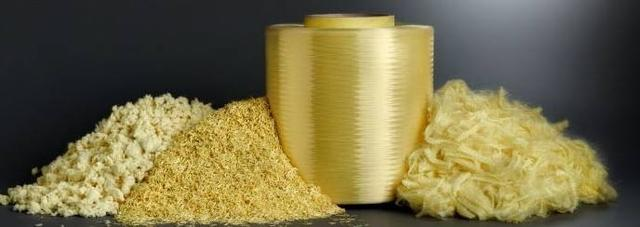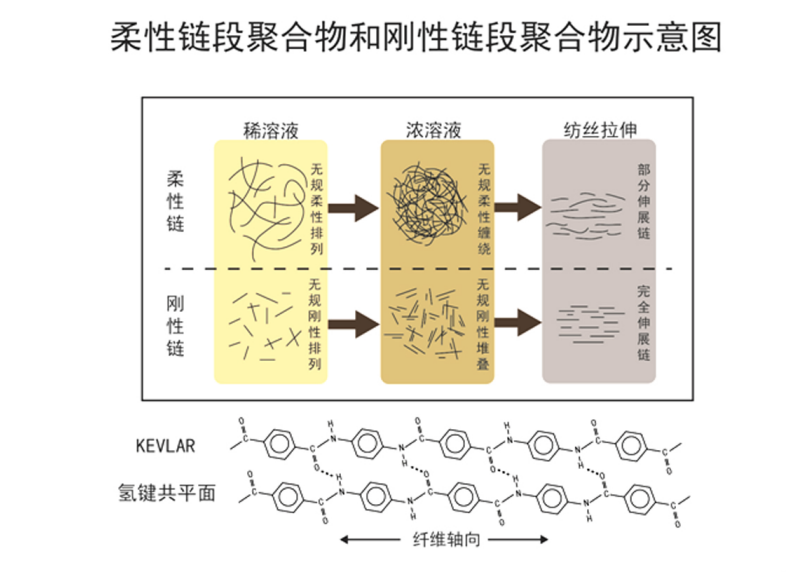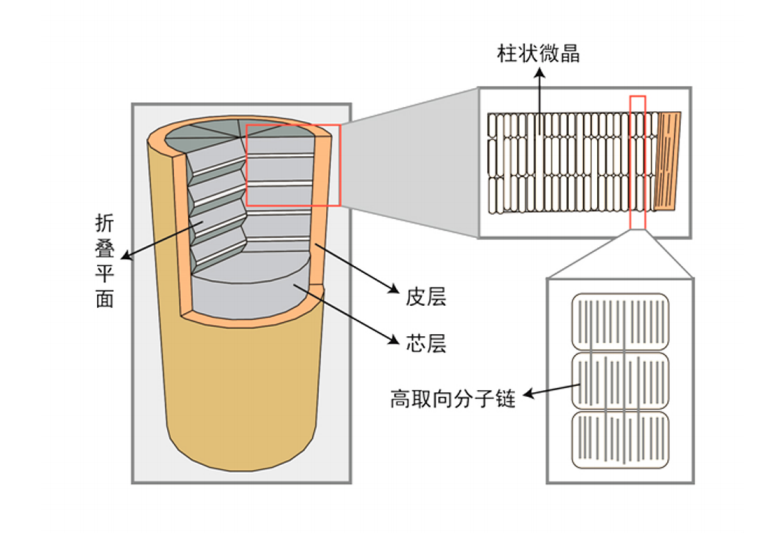Introduction, process and application of aramid fiber
Introduction, process and application of aramid fiber
01Introduction to aramid fiber
The full name of aramid fiber is aromatic polyamide fiber. It is a linear polymer composed of aromatic groups and amide groups. It has excellent mechanical properties, stable chemical structure, ideal mechanical properties, ultra-high strength and high modulus. , high temperature resistance, acid and alkali resistance, light weight, wear resistance and other excellent properties.
Different from ordinary flexible polymer molecular chains, the main chain structure of para-aramid fiber is mainly composed of a rod-shaped molecular structure formed by para-position of benzene rings. Due to the presence of large conjugated benzene rings, internal rotation of molecular segments is difficult to occur, thus Presents a linear rigid structure.
Figure 1 Schematic diagram of flexible chain polymers and rigid segment polymers

The main chain of aramid fiber molecules has good regularity and contains rigid crystallographic units, which can easily form liquid crystal forms. When this kind of rigid molecular chain is in the liquid crystal state, as the concentration increases, it can form a parallel arrangement structure side by side. The internal molecular chain segments appear highly ordered. No special stretching is required. The extended chain structure can be achieved only through spinning orientation. Achieve high modulus.
Not only that, during the spinning process, this structure can also be stacked in high density and multiple layers along the fiber orientation in a limited space, making the polymer higher strength. The molecular chains of aramid fiber are highly oriented along the fiber axis, and the hydrogen atoms on the amide group can form hydrogen bonds with the electron-supplying carbonyl groups on another molecular chain, forming hydrogen bond cross-links between molecular chains.
Aramid fiber contains different forms of supramolecular structures such as core-sheath structure, sub-crystalline structure and microfiber structure. Figure 2 is a schematic diagram of the internal structure of aramid fiber. The skin layer of the fiber is less crystalline than the core layer, and the thickness of the skin layer is about 0.1μm~1μm (it varies depending on the fiber type and spinning process).
The core layer is composed of single crystals arranged along the axis of the fiber. The microcrystals in the core layer are not as highly oriented as the cortex. The molecules in the fiber have an orientation nearly parallel to the fiber axis in the longitudinal direction, and are parallel to the radiation of the hydrogen bonding sheets in the transverse direction. shape orientation.
Figure 2 Schematic diagram of the internal structure of aramid fiber

According to different chemical structures, aramid fibers can be divided into three types: para-aramid, meta-aramid and ortho-aramid, of which ortho-aramid is rarely used.
Aramid 1414——para-aramid
Para-aramid, also known as polyparaphenylene terephthalamide fiber (PPTA) and polyparabenzamide fiber (PBA).
PPTA is obtained by low-temperature solution condensation polymerization of p-phenylenediamine and terephthaloyl chloride as monomers in N-methylpyrrolidone (NMP)-calcium chloride.
The main outstanding advantages of para-aramid are high strength and high modulus. Its tensile strength is 6 times that of steel wire, its tensile modulus is 2 to 3 times that of steel wire and glass fiber, and its density is only one-fifth that of steel wire. It is mainly used in safety protection, bulletproof, rubber product reinforcement, and high-strength cables. and asbestos friction material replacement.

Aramid 1313——meta-aramid
Meta-aramid fiber, also known as poly-m-phenylene isophthalamide (PMTA) fiber, domestic brand aramid 1313.
The molecular chain covalent bond of meta-aramid has no conjugation effect. The rotation potential within the molecular chain is lower than that of para-aramid. The flexibility of the macromolecular chain is stronger than that of para-aramid, and the fiber crystallinity is smaller than that of para-aramid.
Meta-aramid has excellent heat resistance, flame resistance and insulation properties, and is mainly used for fireproof materials and mechanical damage prevention.
The representative American brand is Nomex, which was commercialized by DuPont in the 1960s. Nomex has heat resistance, flame resistance and excellent electrical properties and is commonly used in:
①Protective clothing in fiber form, hot gas filter material;
② Electrical insulation paper and composite lightweight honeycomb structure.
02 The development history of aramid fiber in my country
Our country began the development of aramid in 1972, and passed the identification of aramid 1313 in 1981, and the identification of aramid 1414 in 1985. They are respectively equivalent to the polymerization of the world’s largest chemical company, the American DuPont Company. Material Nomex and Kevlar.
From 1986 to 1990, during China’s Seventh Five-Year Plan for National Economic Development, Beijing Rubber Industry Research and Design Institute, Chenguang Chemical Industry Research Institute, Shanghai Synthetic Fiber Research Institute, Xi’an Jiaotong University and other units jointly undertook the national research on aromatic polyamide resin. A series of scientific research projects on the development of synthesis and spinning technology and their application in the rubber industry, and the corresponding product development and research work has been completed.
In just four years, the performance of para-aramid fiber developed and produced by Donghua University Chemical Fiber Research Institute, Chenguang Chemical Industry Research Institute, Shanghai Synthetic Fiber Research Institute, Shenyang Hongxing Sealing Material Factory and other units has reached the international level.
However, due to resource, cost and other reasons, the fragrance used in our country hasImprove the “raw strength” of the material. Aramid pulp-reinforced brake pads can improve the strength of the preform when it is formed, and can effectively improve the processing technology before the brake pads are vulcanized. Aramid pulp-reinforced friction materials can effectively extend the service life of friction materials and reduce the wear of brake drums or discs and the noise during braking. Aramid pulp also has extremely high chemical and thermal stability, and aramid pulp-reinforced sealing gaskets have excellent strength and wear resistance.
Para-aramid is often used as composite reinforcement, and can also be mixed with carbon fiber and glass fiber.
Composite materials need to be considered to have better cost performance at lower weight. Glass fiber has become the most widely used reinforcing fiber due to its low cost. Carbon fiber has higher strength and modulus and lower elongation, but the preparation cost is higher. Aramid fiber combines the advantages of carbon fiber and glass fiber, while It has the characteristics of high strength, high modulus and low density. When used in reinforced materials, it can greatly improve the impact resistance of the material.
At present, para-aramid reinforced composite materials have been widely used in aerospace components, automotive parts, ships, sports products, pressure vessels and other fields. Para-aramid reinforced hulls provide significant weight savings and provide higher tear strength and puncture resistance than fiberglass composites.
The fishing rod made of carbon fiber and aramid fiber mixed reinforced composite materials has both the longitudinal stiffness provided by unidirectional carbon fiber and the transverse stiffness provided by aramid fiber. It is light in weight, has a stable structure and has good performance.
Aramid-reinforced pipes can be used in oil and natural gas pipelines to replace original steel pipes to avoid leaks caused by corrosion; the reduced weight of the pipes also simplifies the transportation and installation process.
Application of meta-aramid fiber
Meta-aramid has excellent thermal properties and thermal and moisture comfort. Therefore, fabrics made of this type of fiber are not only flame retardant, but also will not melt or drip. They are usually made into thermal insulation in the fields of industry, military, firefighting, automobile racing, etc. Flame retardant protective clothing.
Flame retardant and thermal insulation protective materials often achieve the purpose of blocking flames through heat insulation, reflection, absorption of heat energy, or carbonization of the material itself to isolate heat.
Fire-resistant clothing is usually a special fabric made of a blend of multiple materials or multiple layers of fabric to simultaneously achieve flame retardant and heat insulation and prevent the evaporation of body fluids. Although meta-aramid has a high glass transition temperature and melting point, the fibers will shrink in the flame, resulting in a reduction in the tightness of the fabric, and the gaps between the yarns are too large, which affects the barrier performance. Therefore, it can be used with meta-aramid. Aramid or other material yarns are co-spun to reduce the occurrence of this situation.
05 Summary and Outlook
As a type of high-performance material, the excellent properties of aramid fiber have been developed and applied in different fields. Our country has been researching aramid production technology since the early 1960s. However, due to foreign blockade of key technologies, it only reached the technical level of industrial production of meta-aramid in 2004, and it was not until 2011 that it reached the level of industrial production of para-aramid. techinque level
At present, there is still a certain gap between domestic aramid industrialization and foreign countries. In the next few years, the market demand for aramid fiber at home and abroad will grow rapidly. The main technology research and development directions of my country’s aramid fiber enterprises in the future will be: improving the performance of aramid fibers through copolymerization modification, improving processing and production conditions and reducing fiber production costs; making aramid fibers more durable through surface modification, hybrid fibers and new molding technologies. Fiber can adapt to various uses, improve performance, reduce application costs, etc.







